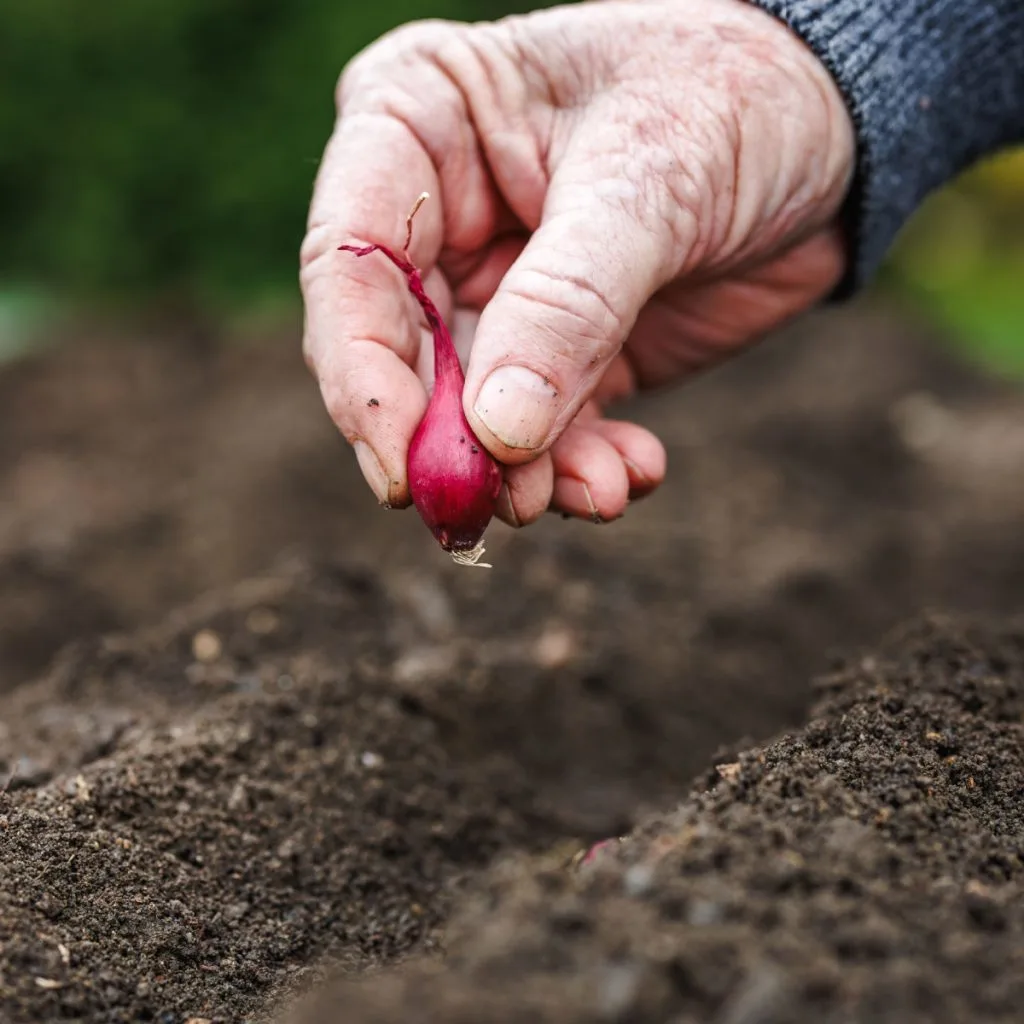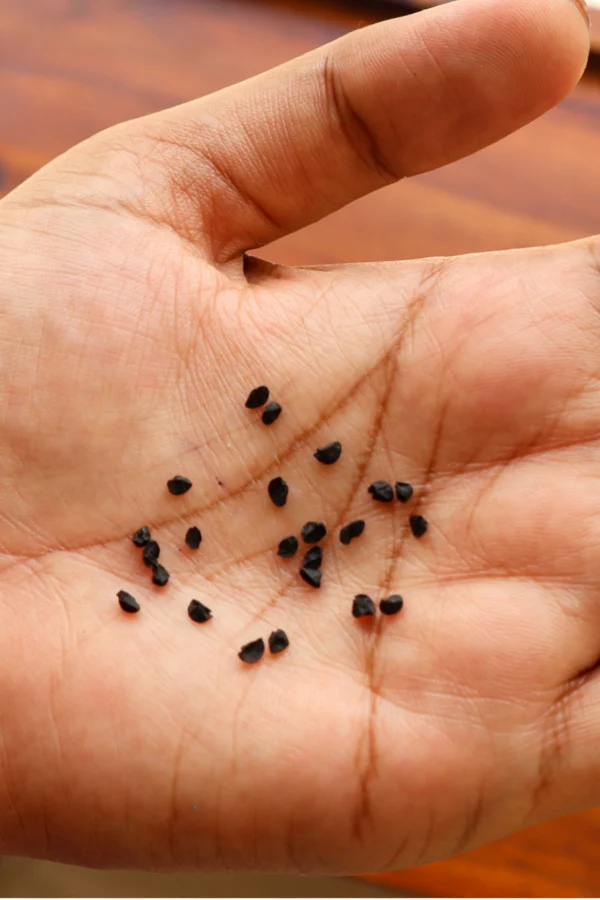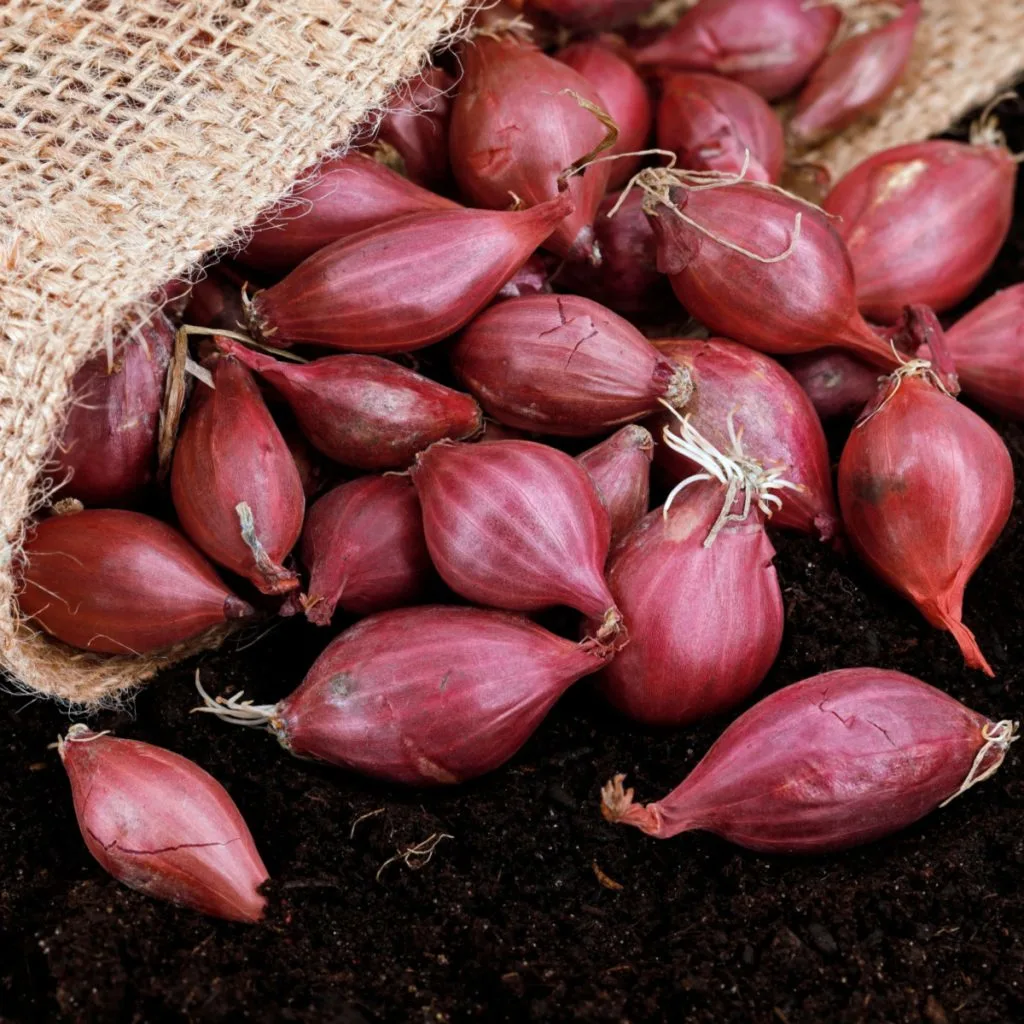When it comes to growing delicious red onions in your garden or raised beds – there is one little secret that can really pay off in producing bigger and more tastier onions. And that secret? Planting red onion sets instead of seeds early in the spring!
With their sweeter flavor and vibrant red flesh, red onions are a favorite for many in the kitchen – whether topping their favorite hamburger or sandwich – or adding big onion flavor to all kinds of great dishes.
But for one reason or another, many gardeners shy away from the trying to grow red onions. The good news? There’s no reason too! In fact, red onions grow just as easily as common yellow and white onions. Especially, as you will see below, when you grow them from bulbs instead of seed!

The Secret To Growing Red Onions
All onions are actually considered to be biennial. That simply means that it takes two full years for the plant to complete its lifecycle. During the first year of growth, the seeds grow into small bulbs. It’s in the second year, that the small onion bulbs, more commonly known as onion sets, will then grow into the larger bulbs.
Beyond the fact that onion sets will produce larger bulbs than seeds, there are also several other advantages that make planting onion sets the way to go. Affiliate Link: Red Onion Sets For Spring Planting.
First and foremost is the ease of planting. Onion sets can go in the ground much earlier than seeds. With seeds, you need to wait until after your last potential frost date. But with onion sets, they can go in the ground two to four weeks before your last frost.
Another advantage of sets is the size. Onion seeds are tiny. Not only can it be difficult trying to plant the minuscule seeds into the soil, it can be even harder to tend to them. The tiny seedlings can also have difficulty establishing in the soil.
Seeds can take a little while to germinate. That often allows weeds to pop up before, taking over the weeding rows. And when the seeds do sprout, the ultra-thin seedlings are often confused for weeds and pulled out.

Planting & Growing Red Onion Sets
Red onion sets need to be treated just a little bit differently than seeds when planting since the sets are in their second year of growth.
Choose onion sets that look healthy and have a somewhat firm small bulb. Discard or compost any sets that are soft and extremely small. When you start with a strong, healthy onion set, you have a better chance of it growing into large, firm bulbs.
Choose a growing location that receives full sun. Red onions grow best when they get at least six to eight hours of sunlight each day. Once soil temperatures reach when soil temps are 55-60º Fahrenheit, you can plant outside. Amend your soil with plenty of compost and sand to keep it loose and well draining.
Red onions, like all other onions, need loose, well-draining soil in order to grow properly. They will struggle in soil that is heavy and clay-like. If possible, amend with plenty of sand and compost.
Plant each onion bulb about one inch deep with all of their roots fully covered. Ensure that the pointy end is up when planting so the shoots can grow upward and the roots can grow down. Space bulbs about four to six inches apart in all directions. Water well after planting.

Long-Term Care
Since onion roots don’t grow really deep in the soil, they will need to be watered a bit more often than some of your other plants. If the top few inches of soil is dry, it’s time to water. This will likely mean you will need to water once or twice a week, especially during really warm weather.
When watering, do so in the morning to allow the onions to dry out some during the day. When you water late in the day, the onions can stay too wet, and that can lead to them rotting out.
Once your red onions grow a few inches above the soil line, it’s a good idea to add a layer of natural mulch. Using mulch is a great way to snuff out weeds, help retain moisture, and help to regulate soil temperatures.
Shredded leaves, straw, and grass clippings are all excellent natural mulches. Add more mulch as the onions begin to grow more. Aim for a total of four inches of mulch by late spring / early summer.
When To Harvest Red Onions
You can harvest red onions at almost any time during the growing season. In fact, you can harvest red onions as scallions after just a couple of weeks of growth. You can also harvest them as spring onions a few weeks after that.

For larger red onions, allow the plant to grow to maturity. Once you notice that around a quarter of each onion top has started to yellow, stop watering. This will allow the soil to dry up and make harvesting much easier.
Then, when the foliage is mostly yellow and the tops have fallen over, the plant is ready for harvesting. Always wait until the soil has a chance to dry up a little bit before harvesting.
Use a small garden trowel to carefully dig below the onion bulb and gently pull it up. Be careful not to cut into the bulb. Shake off any excess soil but do not wash off bulbs at this time.
The bulbs now need a couple of weeks to cure. Place onions in a single row in a dry location that has good airflow. A wire rack or large screen works well. Once onions are cured, you can cut off the roots and tops, storing them in a location that is around 35 to 40º Fahrenheit.
With proper curing and storage, you and enjoy your red onions months after harvesting. Here is to growing your own delicious crop of red onions from sets this year! And if you are looking to start that garden with other early crops, check out our article: The Best Spring Seed Crops To Plant Now To Jumpstart Your Garden Early!
Simple Garden Life
Follow Our Facebook Page For Even More Great Tips! Simple Garden Life Facebook Page
Simple Garden Life is a website dedicated to keeping gardening fun, simple and enjoyable! We publish two new articles each week along with a new garden podcast episode every two weeks. This article may contain affiliate links.
